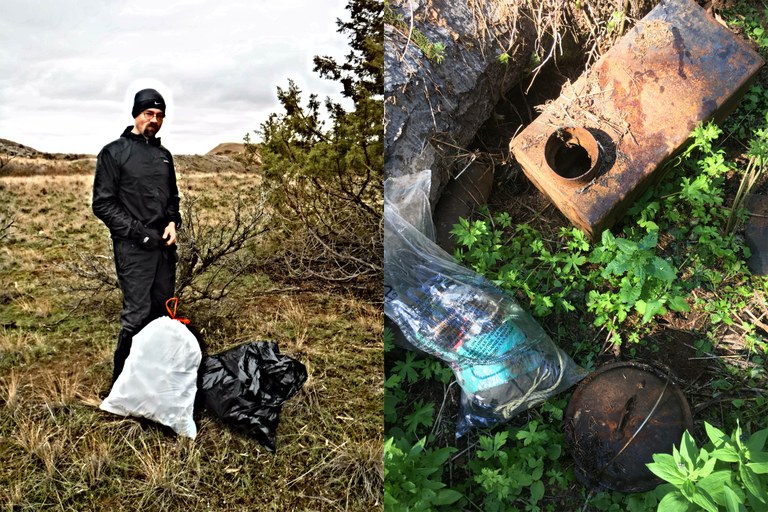3 Ways to Tackle Trash on Trail
Being an advocate for trails can mean many things — even picking up trash. That’s why WTA is asking hikers to make a pledge to pick it up and pack it out.
Being an advocate for trails can mean many things — even picking up trash. That’s why WTA is asking hikers to make a pledge to pick it up and pack it out. To inspire you, we asked Holly Weiler, WTA’s Eastern Washington regional coordinator and enthusiast for leaving places better than she found them, to talk about the types of trash you might find and how to deal with it.
Tucked into a pocket of every backpack I own is at least one plastic bag earmarked for the inevitable trash I find along trails and in campsites.
Accidental Trash
Frequent finds consist mostly of microtrash: a corner of a granola bar wrapper that was accidentally dropped on trail, or the top of an instant-coffee packet in a campsite. These pieces of trash are easy to pick up: Just tuck them in a hip pouch or small bag. You barely even need to pause. I’m happy to help pack out these likely inadvertent pieces of litter, as this kind of trash can come from even the most conscientious hiker.

Clearing trash in Juniper Dunes and at the Thunder Creek campsite. Photos courtesy Holly Weiler.
Rarely fun, but cool if you do
More troubling are the deliberate forms of trash. I once carried 11 full freeze-dried meals and four partial propane canisters from the Little Snowy Top Lookout in the Salmo-Priest Wilderness. Rodents had already gnawed their way into most of the food packets. Balloons, food and nearly empty canisters are all types of trash left behind by folks who don’t fully think through the consequences of their decisions. Hiking out this type of trash takes more work — and more dedication. It helps to always have a trash bag in your backpack so you can pack it out more easily.
A collective effort
Then there is the type of trash that makes me truly angry with whoever left it: the deliberate rubbish heap. Along North Fork Asotin Creek, I found a hollow tree stump stuffed with aluminum and plastic trash. In the dry Juniper Dunes Wilderness, a friend and I filled two large trash bags with empty water bottles after someone apparently packed in several cases of water and dumped the empties beneath a large juniper tree. Deep in the Wenaha Tucannon Wilderness, I found multiple campsites with abandoned camp equipment and trash. One such camp, when reported to the U.S. Forest Service, required nine mule loads to pack out everything. Another had a tarp-covered structure, built out of trees illegally cut from the surrounding forest using chainsaws. I knew this because the culprit left the majority of their bar-and-chain oil behind.
The best method of dealing with this last variety of trash is to report it to the land manager for the area in question. I capture the GPS location and snap a few photos, then pass the information along. It’s an easy way to help overburdened agencies by being their eyes on the ground, and it helps provide a better experience for the next visitor. (Not sure who the land manager is? Check our hiking guide entry for the trail in question.)
For really bad trash like this, I generally pack out what I can, choosing the most damaging trash (hammers and nails; zip ties; rope, string or wire tied tightly around live trees) or items that I might be able to repurpose. On one recent trip in the Salmo-Priest Wilderness, I found a Dutch oven! I carried it 7 miles to the car. It’s a little rusty and will require a bit of work to make it usable, but once it is cleaned up, it will be my kitchen item with the best back story. Next time you’re out on trail, do your part to leave it nicer than you found it.
SIGN THE #LEAVENOTRASHONTRAIL PLEDGE
Show you are committed to leaving no trace on Washington's public lands, in the present and the future.
Next time you're on the trail, pick up a piece of trash and pack it out. It's as easy as that.


Comments
mtnlou on 3 Ways to Tackle Trash on Trail
I carry coffee bean bags to collect garbage when I hike. Many of the bags are self-sealing, they deflect odors and they are a way to re-purpose items that would otherwise be thrown away. There are enough coffee shops and coffee drinkers in Seattle to provide a never-ending supply.
Posted by:
mtnlou on Sep 29, 2018 09:49 AM